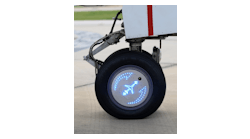MRO Operations: Inside the American Airlines Wheel & Brake Center
When you are responsible for 25,000 wheels and 5,300 brakes each year, you learn a few things about how to do it better, faster, and with regard for the environment.
In a former Builder’s Square facility covering some 106,000 square feet in Tulsa, OK, is where American Airlines overhauls and repairs 100 percent of the worn wheels and brakes removed from its mixed fleet of Boeing 737, 757, 767, 777, and MD-80 aircraft.
It’s a stand-alone facility, with the engineering, machining, welding, and flame spray capabilities as required to repair any discrepancy indentified during the throughput inspection that starts with two to three stage cleaning process.
All the functions of shipping and receiving the tons of wheels, tires, and brakes take up a lot of time and space; and the assembly and post-assembly balancing and inspections keep the rest of the cross-trained work force busy. (“Wheel” employees stay with wheels; “brake” employees stay with brakes, but each group is flexible in its assignments, so that throughput can be maintained in the face of sicknesses, vacations, etc.)
Movement and cleaning
The large work floor is arranged with the two lines wrapped in two concentric “horseshoes” around the circumference, the wheel line outside the brake line, reflecting the relative sizes and populations of the components. Scott Feldman, manager, Composite Repair Center, Wheel and Brake Center and Outside Services, says that one of the toughest parts of the system is one of the first operations: getting the wheels cleaned for inspection in minimum time, while making minimum impact on the environment. Complicating this job is the fact that 777 wheel halves, for example, weigh 140 pounds each – and these wheel assemblies come in and leave the facility complete with tires.
A powered roller conveyor system does a lot of the transport duty through the process, and specialized machines lift and turn heavy assemblies, but there is plenty of manual labor available, and skill and attention are required at each workstation. Though many employees stay for decades (20- and 25-year anniversaries are relatively common), there is higher turnover among newer hires.
Solvents that would make short work of the wheels’ grease and brake dust can also make short work of tires, and cleaning must be done before disassembly. So, a hot water spray pre-wash line does the majority of the cleaning; then dedicated washers do the rest. The two-stage system saves “tons” of water, and results in less volume of wash-off per unit of waste, making water recovery more efficient, as well. In fact, virtually all cleaning at the Wheel & Brake Center (WBC) is water-based. Even bearings are washed in 180 F high-pressure water rather than solvents.
The components are broken down and sent to their inspections; or sometimes to rework, or to recycling – wheel halves, tires, hardware, bearings, brake components – each gets cleaned and goes through a visual inspection, before being sent to final cleaning and beyond.
American’s efficient high-volume cleaning operations make everything else go faster and make work more accurate. Inspection is tailored to the components: both ultrasonic and eddy current inspections are used on nonferrous parts; magnetic particle inspections are also performed on steel parts, including fasteners.
Tires are not automatically discarded; they are replaced on an as-needed basis. When the wheels come in (typically after three months in service), they are returned to the OEM for recapping and reuse after the inspection at that facility has verified them safe and reliable for the re-treading operation. Many are recycled up to six times before being discarded.
Any specific wheel or brake is usually out the door within a week, though some require repairs and take a couple days longer. Components are not kept together in sets: brake parts or wheel halves will probably not leave the shop mated to the same other parts. Not having to keep sets together means that parts can be used as-available; nothing has to wait for original mates.
American’s vertical integration means that 100 percent of the work is done in-shop: engineering, repair, alodine finishing, mounting, and brake relining. Doing everything in-house reduces cycle time, saves shipping costs, and reduces inventory.
No longer is every wheel stripped of paint. “We don’t just paint wheels for the heck of it,” says Carl Black, Wheel & Brake Center supervisor. Stripping takes time, and so does painting, which also adds weight. Inspection cycles are so short (even “total rebuilds” take place each 18 months) that corrosion rarely takes hold -- the alodine coating does a sufficient job of adequate protection. “We don’t remove intact paint unless absolutely necessary for inspection,” he says, “and putting on new paint every time would serve no practical purpose.”
Brakes and critical steps
However, every overhauled brake does get relined. In fact each steel brake contains approximately 140 of pads on five stators in assembly with four rotors, a pressure plate, and torque tube at an estimated overhaul cost of around $10,000 per brake. In comparison, a carbon brake (where each stator and rotor is individually machined from a carbon disc) can carry a full-stack cost of up to $50,000; they’re used in certain applications where the significant weight reduction and increased service life produce cost-justifiable long-range efficiencies.
Some critical steps of assembly are automated, and the precision of the automation prolongs the service life of components. For instance, the auto-torque that reunites wheel halves holds +/-2 percent torque tolerance, better than the 4 pecent a worker achieves manually with a torque wrench. There is plenty of manual labor in the tire inflation cages (nitrogen only), and in the soap-check for leaks. The visual soap-check is extremely effective when performed by the right people; Black estimates that this improved method alone saves a day of turnaround, and commensurate inventory and floor space.
In most cases, the common hardware, things like the bolts and nuts that hold the wheels together, are re-used. Because all the assembly and disassembly is performed using dedicated tools that fit the parts and automatically and precisely achieve the proper torques, hardware lasts a long time, though visual inspection is performed at several stages: disassembly, cleaning, and reassembly.
Tires, as mentioned earlier, often go through more than one trip to the Tulsa facility. The old adage of the squawk, “Right inside main tire almost needs replacement” followed by the log entry, “Almost replaced right inside main tire” reflects business sense and a lot of common sense, and American’s people in Tulsa like common sense.
With this much volume, the Wheel & Brake facility sends a full truck to DFW (Dallas) and ORD (Chicago) each day; other locations are served by FedEx, except for some urgent AOG situations, when wheels and brakes are sometimes shipped as cargo in American’s fleet.
The overall impression one gets when walking in the huge doors is one of organized, 19th century factory labor. However, as one gets close to each station, the care for both employees’ backs and the environment is crystal clear. The pre-wash, the all-water cleanings, the re-use of water -- all these belie an undercurrent of care for those who are downstream, both literally and figuratively. The attention is there for the regulations, of course; but the impression is that the Wheel & Brake facility does these things because they’re the sensible things to do. The ultimate result is greater cleanliness and greater resource savings, plus occasionally having a jump on new regulations.
Management is on the floor much of the time, keeping an eye on workflow and looking for – and listening for – improvements, which are frequently offered, examined, discussed … and implemented.
Beyond this, each stage is optimized for efficiency, minimum movement of parts, trackability, and balance with the rest of the system. A shop of this size is a giant machine itself, and each component both depends on and supports other components. Cross-training goes a long way toward continuing efficiency, as one operation can get help from another to keep work steadily moving. Another advantage is that each worker has an appreciation for every other worker, and thus can work to make everyone’s jobs easier, smoother, and safer – and when these giant parts are moving through the building at a fair clip, safety is on everyone’s mind, as is the ultimate use to which these critical parts are put.
Tim Kern is an aviation writer, aircraft builder, and private pilot. He is based in Anderson, IN, and can be reached at [email protected].





